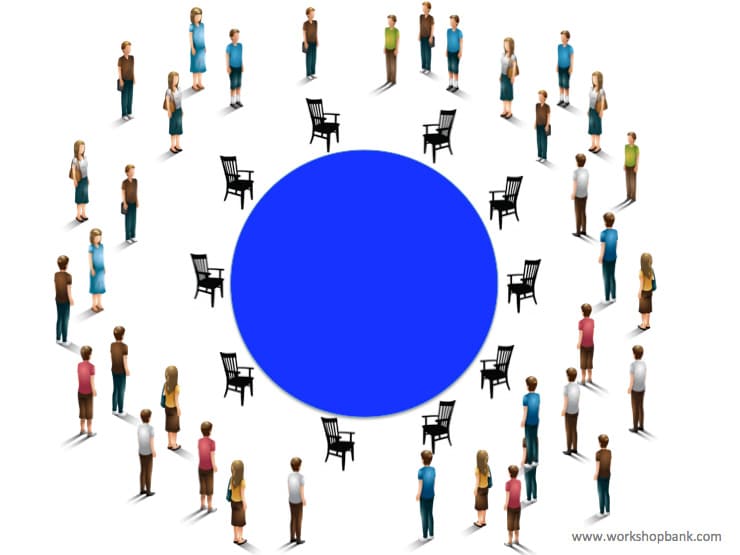Do you want all your key stakeholders pushing with, or against, you and your objectives?
You want them with you, I’m sure. But maybe you don’t have the time to convince every person one-on-one?
Perhaps you have done your Stakeholder Map and you’re wondering what you do now?
Here’s the thing. When decisions and actions are made by a small number of people in isolation that impact a wider stakeholder group you often run into problems.
The wider group don’t feel part of the process so will often react against your agenda of change.
Something you might consider doing is to run a Fishbowl Discussion.
A Fishbowl is a technique used to help a large group of people reach a common understanding on a set of issues or proposal and increase their feeling of participation. In a relatively short amount of time.
Objectives
- The fishbowl process aims to increase the understanding of a large group of other people’s perspectives on an issue or proposal, and to allow them to make connections and recognize links that may have been hidden in a short amount of time.
What is a Fishbowl Discussion?
- A Fishbowl Discussion is an inner group of participants in a roundtable format going through a decision making process that is ‘witnessed’ by a larger group standing behind them who have the opportunity for input and questioning.
- It can be adapted with the use of role-playing techniques to highlight conflicts and alliances.
When Would You Use It?
- When you need to have a far-reaching consultation on a controversial topic with the broader community.
- If you would like participants and observers to leave with a greater understanding of the range of opinions that exist within their community.
- To help a large group feel that their views have been represented in a discussion, even when they have not themselves had any input.
- When you are looking to build trust with the wider group by creating a sense of transparency in decision making.
Resources Required
- 1 hour.
- Large room with plenty of wall space for putting up flip-chart papers.
- 1 large round table with 10 chairs.
- Between 15 to 50 people (no more than 8 should sit around the table (plus the 2 empty chairs) with the remaining people as observers).
- 1 Lead Facilitator controlling the process and at least 2 others capturing discussion and managing questions and answers.
- Enough chairs for all who are sitting around the table.
- Notepads and pens for everyone.
- Projection screen, projector and computer (if a short presentation is required to kick the discussion off).
- Flip-chart to capture the discussion.
Process
- When planning the session with your sponsor agree who the Participants and Observers should be.
- On the day, before the discussion kicks off, run through the process and role descriptions of the session.
- The Facilitator should co-create a set of Ground Rules with the Group (e.g. no interrupting, treat each others opinions with respect, approach each new idea with positivity, respect the integrity of the process etc.)
- The Sponsor provides a brief presentation (no more than 5 minutes) of the situation or proposal on the table for discussion.
- The Facilitator then helps the Participants start discussing the situation.
- If an Observer would like to actively input then they can sit down in one of the empty chairs and wait for their moment to talk.
- There should always be 2 empty chairs available around the table so during a natural pause in the discussion, if this isn’t the case at any time, the Facilitator should ask if there is anyone around the table who would like to join the Observers.
- Allow the discussion to continue until, either it dries up, or 10 minutes before the session is scheduled to end.
- The Facilitator then leads a 10 minute plenary discussion for the remainder of the session where all Participants and Observers can offer their final thoughts to the wider group.
- The Facilitation Team then compile a report on the discussion and ensure that all decisions are highlighted for the action team to take forward.
Variations
Closed Fishbowl Discussion:
- The process described above is called an ‘Open Fishbowl’.
- You can also do what is called a ‘Closed Fishbowl’ where all 10 chairs are filled and then after 10 minutes all 10 people swap with 10 different Observers for them to continue the discussion.
- And so on so all people who want to actively participate get their opportunity.
Secret Sauce
- The Sponsor’s presentation is critical for the success of the session. It should be brief, to the point, and as neutral as possible so as not to lead the discussion in one direction or another.
- Make sure you prepare the Sponsor appropriately and, if possible, know exactly what they are going to say beforehand.
- As long as physical contact is appropriate in your culture encourage Observers to tap on Participants’ shoulders to take their place in the fishbowl as this will allow the discussion to continue uninterrupted.
- The magic of this process lies in the personal reflection of each attendee after the event. It might seem like it “was just a talking shop” and that “there were no firm decisions or actions that came out” but because the discussion was so open and transparent a lot of people will suddenly share a common understanding that may not have happened otherwise.

